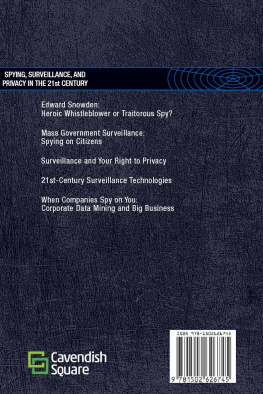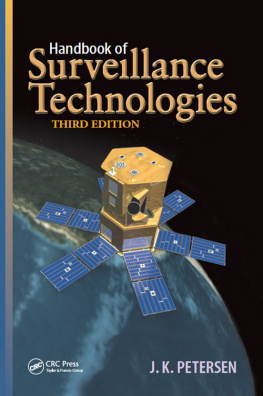Published in 2018 by Cavendish Square Publishing, LLC
243 5th Avenue, Suite 136, New York, NY 10016
Copyright 2018 by Cavendish Square Publishing, LLC
First Edition
No part of this publication may be reproduced, stored in a retrieval system, or transmitted in any form or by any meanselectronic, mechanical, photocopying, recording, or otherwisewithout the prior permission of the copyright owner. Request for permission should be addressed to Permissions, Cavendish Square Publishing, 243 5th Avenue, Suite 136, New York, NY 10016. Tel (877) 980-4450; fax (877) 980-4454.
Website: cavendishsq.com
This publication represents the opinions and views of the author based on his or her personal experience, knowledge, and research. The information in this book serves as a general guide only. The author and publisher have used their best efforts in preparing this book and disclaim liability rising directly or indirectly from the use and application of this book.
CPSIA Compliance Information: Batch #CS17CSQ
All websites were available and accurate when this book was sent to press.
Library of Congress Cataloging-in-Publication Data
Names: Harmon, Daniel E.
Title: 21st-century surveillance technologies / Daniel E. Harmon.
Description: New York : Cavendish Square, 2018. | Series: Spying, surveillance, and privacy in the 21st-century | Includes index.
Identifiers: ISBN 9781502626745 (library bound) | ISBN 9781502626691 (ebook)
Subjects: LCSH: Electronic surveillance--Juvenile literature. | Security systems--Juvenile literature.
Classification: LCC TK7882.E2 H37 2018 | DDC 005.8--dc23
Editorial Director: David McNamara
Editor: Fletcher Doyle
Copy Editor: Nathan Heidelberger
Associate Art Director: Amy Greenan
Designer: Stephanie Flecha
Production Coordinator: Karol Szymczuk
Photo Research: J8 Media
The photographs in this book are used by permission and through the courtesy of:
Cover Erik Simonsen/Photographers Choice/Getty Images; p. 6 Gregory R Todd, rotated by Artem Korzhimanov/Wikimedia Commons/File:Dawn of the Space Age (rotated).jpg/CC BY SA 3.0; p. 7 Bride Lane Library/Popperfoto/Getty Images; p. Larry Ellis/Express/Getty Images.
Printed in the United States of America
Contents
A New Age in Surveillance Technology
Benefits of Government and Civilian Surveillance
Objections to Surveillance Technology
The Technology Debate Continues
Surveillance Technology Timeline
Glossary
Further Information
Bibliography
Index
About the Author
An artists rendering shows Sputnik in orbit around Earth. Sputnik I was launched in October 1957.
CHAPTER 1
A New Age in Surveillance Technology
T he world entered a startling, uncertain new era on October 4, 1957. TASS, the Russian news agency, issued a sensational report that the Soviet Union had successfully launched the worlds first man-made satellite, Sputnik I, into orbit around Earth. The craft took only an hour and a half to complete a circuit around the globe.
It was the time of the Cold War. During World War II (1939 1945), Germany, the United States, and the Soviet Union began developing nuclear weapons programs. After the war ended, the two emerging superpowers accelerated rocket and missile testing, each seeking to gain an advantage over the other. By the time the first Sputnik was launched, an attitude of gloom had spread worldwide. World War III, doomsayers warned, would end the human race. Until the breakup of the Soviet Union in the late 1980s and early 1990s, international politics and economic strategies were affected by Cold War jockeying for nuclear and military supremacy.
As Americans pondered the implications of Sputnik, they became unnerved. Thousands ventured out uneasily at night to scrutinize the sky, looking for the tiny bright speck moving across the starry tapestry in its periodic transit. A thought ran through the minds of millions: The Russians are taking aerial photographs of our military installations. Satellite cameras even could be photographing us as we walk our streets and relax in our yards.
The fear would prove to be greatly exaggeratedbut not entirely baseless. The United States launched its own first satellite only three months later. These early Soviet and American satellites mainly were engineered not to take pictures but to record scientific data concerning the upper atmosphere, such as its temperature, density, and chemical composition. Soon enough, though, dedicated spy satellites became a reality.
The military spy programs of many countries besides the United States and Russia have benefited greatly from space technology. The rate of advance has been astonishing. However, the extraordinary capability of state-of-the-art, high-altitude reconnaissance instruments is but one facet of twenty-first-century surveillance technology. Government agencies, police departments, detective services, criminal organizations, and ordinary individuals now have remarkable snooping tools at their disposal that were undreamed of when the first Sputnik went into orbit.
This has presented a problem. The astonishing capabilities of surveillance technology in the twenty-first century have enabled scientists, peacekeepers, and emergency responders to understand, foresee, and react to a world of global crises and neighborhood emergencies. At the same time, they have triggered suspicions of privacy invasionwhich in fact occurs, in one form or another, every day.
The Pinkerton eye illustrated the dectective agencys main investigative tool: visual surveillance.
The famous Pinkerton National Detective Agency, founded in 1850, adopted as its motto the stern warning phrase We Never Sleep. The implication was that its growing staff of detectives was at work around the clock to bring criminals to justice. Today, in the same vein, surveillance never stops. Powered by more and more sophisticated technology, many types of surveillance occur worldwide from the air and the sea, as well as on land. Surveillance also pervades the internet.
Whenever you enter a public placeschool grounds, a city sidewalk, a mall, a supermarket, a restaurant, a park, a passenger planeyou may be losing control over your privacy. Someone unnoticed could be taking your picture or recording a video or sound clip of you. A stranger passing by could be wearing a video camera pen, recording unflattering remarks youre making to a companion. In the twenty-first century, its conceivable that youre caught on candid camera every day. Your image and voice could turn up on social media platforms in a very embarrassing light.
Cyber Surveillance in Politics
One or more hackers gained access to email memos that were transmitted among staff members of the Democratic National Committee (DNC) during the 2016 presidential election campaign. In July of that yearjust days before the Democratic National Convention beganalmost twenty thousand of the messages were released by WikiLeaks. They contained controversial exchanges in which, for example, Democratic political operatives had discussed ways to disparage Senator Bernie Sanders of Vermont, the leading party rival to Hillary Clinton during the primary season. As a result of the email scandal, DNC Chairwoman Debbie Wasserman Schultz and other committee leaders were forced to resign.
















